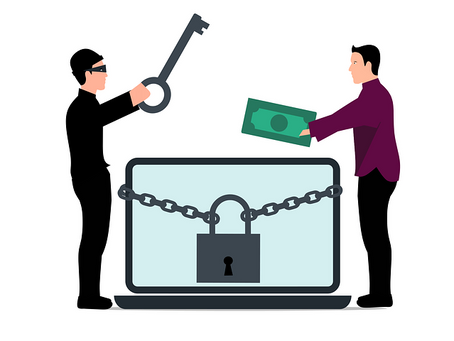The 8 Types of Ransomware
Share

image courtesy pixabay.com
Ransomware is a term that strikes fear into the hearts of individuals and businesses alike. In recent years, the frequency and sophistication of ransomware attacks have escalated, causing significant disruptions and financial losses across the globe. Understanding the types of ransomware is crucial for devising effective prevention and mitigation strategies. This blog will examine various strains of ransomware, shedding light on their characteristics, modes of operation, and prevention measures.
Background
Ransomware is malicious software designed to encrypt files or entire systems, holding them hostage until a ransom is paid. The perpetrators, often cybercriminals, demand payment in cryptocurrency, making it challenging to trace the transactions. Ransomware attacks have evolved, giving rise to different types, each with its unique characteristics and methods of infiltration.
Types of Ransomware
Crypto Ransomware
Crypto ransomware is the most prevalent type, encrypting files and demanding a ransom for decryption. The encryption used is often strong and almost impossible to break without the decryption key held by the attacker.
Locker Ransomware
Locker ransomware locks the victim out of their operating system, preventing access to files and applications. It typically displays a full-screen message with ransom instructions. Unlike crypto ransomware, it doesn’t encrypt files but denies access to the entire system.
Scareware
Scareware displays false or exaggerated threats to trick users into purchasing unnecessary or fake antivirus software. Though it doesn’t encrypt files, it is a form of ransomware as it extorts money under false pretenses.
Doxware (Leakware)
Doxware threatens to publish sensitive or private information unless a ransom is paid. Attackers gain access to files, and if the victim refuses to pay, the information is released, potentially causing significant reputational damage.
RaaS (Ransomware-as-a-Service)
RaaS is a business model where cybercriminals offer ransomware services to other attackers for a fee or a percentage of the ransom. This has lowered the barrier to entry, enabling even those with limited technical skills to conduct ransomware attacks.
Mobile Ransomware
As the name suggests, mobile ransomware targets smartphones and tablets, encrypting files or locking the device. This type has gained traction as mobile usage continues to rise.
Wiper Ransomware
Wiper ransomware, instead of encrypting files, wipes or destroys data, making it irrecoverable. The motive remains the same – extortion through fear and disruption.
Double Extortion Ransomware
In this variant, cybercriminals not only encrypt files but also exfiltrate sensitive data. They threaten to publish the stolen data unless a ransom is paid, adding another layer of pressure on the victim to comply.
How Ransomware Operates
Understanding the modus operandi of ransomware is essential in devising effective preventative measures.
Delivery
Ransomware can be delivered through email attachments, malicious links, drive-by downloads from compromised websites, or exploiting vulnerabilities in outdated software.
Infiltration
Once the victim clicks on the malicious link or attachment, the ransomware infiltrates the system and starts encrypting files or locking the system.
Encryption
The ransomware uses strong encryption algorithms to lock files, making them inaccessible to the victim.
Ransom Note
After encrypting files, the ransomware displays a ransom note, typically demanding payment in cryptocurrency and providing instructions on how to pay.
Payment and Decryption
If the victim pays the ransom, the attacker provides the decryption key. However, paying the ransom is discouraged, as it funds criminal activities and provides no guarantee of recovering the files.
Prevention and Mitigation Strategies
Prevention is the key to combating ransomware. Here are effective strategies to protect against ransomware attacks:
Regular Backups:
Maintain regular backups of important files and store them in secure, off-site locations. In the event of a ransomware attack, this will enable you to restore your files without paying the ransom.
Update Software
Keep all software, including operating systems and applications, up to date to patch vulnerabilities that cybercriminals might exploit.
Educate Employees
Conduct regular training sessions to educate employees on identifying phishing emails, suspicious links, and attachments. Human error is a significant entry point for ransomware.
Use Antivirus and Anti-Malware Solutions
Employ reputable antivirus and anti-malware software to detect and block ransomware before it infiltrates your system.
Implement Network Segmentation
Segment your network to limit the spread of ransomware within the organization, isolating infected systems from the rest of the network.
Access Control and Least Privilege
Limit user access to only the resources necessary for their roles. Implement the principle of least privilege to minimize the potential damage from a ransomware attack.
Incident Response Plan
Develop a comprehensive incident response plan to swiftly and effectively respond to a ransomware attack, minimizing the impact on your organization.
Final Note
Ransomware continues to be a persistent threat in the digital domain. Understanding the various types and their methods of operation is critical for organizations and individuals to stay ahead of cybercriminals. Employing a multi-faceted approach that includes regular backups, employee education, updated software, and proactive security measures will strengthen defenses against this menacing form of cybercrime. Note that prevention and preparedness are your best allies in the battle against ransomware.



I like this site very much, Its a rattling nice office to read and obtain info.